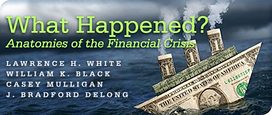Lawrence White writes:
Professor DeLong says little to emphasize the cluster of malinvestments, the rafts of investment projects — particularly in real estate — that have turned out to be wealth-squandering mistakes, leading to the writing down of financial claims that funded them…
I protest.
White misses my point. We have, at most, $2T of losses in securities backed by real estate investments. This is a smaller downward shock as a share of relevant financial wealth than was the collapse of overoptimism about Silicon Valley in 2000-2001, than were the triple shocks of East Asia and Russia and LTCM in 1997-1998, than were the S&Ls at the end of the 1980s, than was the portfolio insurance crash of 1987, et cetera, et cetera, et cetera.
Yet this particular downward shock has triggered a tenfold financial accelerator — a $20T collapse in the value of financial assets worldwide. That there are “malinvestments… wealth-squandering mistakes” some of them obvious ex ante but most of them only obvious ex post (which doesn’t stop people from claiming that they were obvious ex ante) is simply not news.
White’s theory seems to be that our current crisis is deserved and inevitable retribution for financial fecklessness. That theory fails. There have been many past episodes of greater fecklessness. And they have not been followed by any equal or proportionate retribution.
White’s position is, I think, a normal reaction derived from monkey psychology — the band of monkeys hangs together better if monkeys fear that they will be punished if they transgress the rules. But I don’t think it helps us understand what is going on very much.

